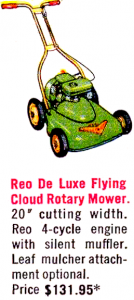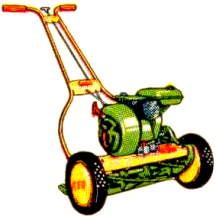A BRIEF HISTORY OF THE REO ENGINE
1949-1958
REO data used by permission of Erv Troyer.
The name REO originated from the initials of a man named Ransom Eli Olds, who was involved in many enterprises in and around Lansing, Michigan. The founder of the Olds Motor Works and REO Motors, Olds was part-owner in a number of other companies which were involved in trucks, automobiles, and engines. These companies included Olds Gas Power Company, Original Gas Engine Company, and Ideal Motor Company, which built stationary engines. When Ransom Olds died in 1950, at the age of 86, he was no longer connected with any of these companies.
REO Motors became well-known for its trucks and supplied many trucks and engines for the US military during World War II. Following the post-war boom, however, truck sales slowed down drastically in early 1949, but its engine-powered lawn mower division, which had been established three years earlier, helped the company survive during this time.
Joseph S. Sherer,Jr., was president of REO Motors at the time when the lawn mower line was started. Mr. Sherer, a graduate of MIT, formerly had been Vice-president and General Manager of Ideal Lawn Mower Company of Lansing. He brought several engineering and sales people with him from Ideal.
REO started the Lawn Mower Division in 1946 with a 17-inch push-type mower and a 21-inch engine-powered reel-type mower. At this time, REO was using Clinton and Briggs & Stratton engines, but engineer Francis Korff was busy developing REO’s own engine in REO’s engineering lab. That engine was introduced in 1949 and became a great success. It was a well-built cast-iron engine, with its head slanted at 45 degrees. It ran “backwards,” that is, the flywheel rotated counter-clockwise, which was opposite from most other engines. The power, however, was taken from the camshaft, which meant that the drive pulley turned in the same direction as other engines, at 1/2 the speed of the crankshaft. The intake and exhaust valves were both operated by a single cam lobe on the camshaft. A variation of the basic engine with a 6:1 gear reduction was used on REO’s deluxe lawn mower, the Trimalawn, and was also used on a snow blower several years later.
REO also made an item called the Trollabout, which was made for installation in a rowboat. The standard REO mower engine was mounted on a slightly tilted platform inside the boat, and a power shaft went through the bottom of the boat to drive an aluminum prop — the common man’s inboard-outboard! I have heard a very interesting story concerning the introduction of the Trollabout: One of the company officials who was trying to promote it had called newspapers and radio stations to demonstrate it. Someone had apparently done a poor job of installing the Trollabout, not having caulked properly around the hole where the prop shaft went through the bottom of the boat. Right in front of everybody, the boat sank! That might just explain why the product was never very popular.
During the post-war era, the power mower was in great demand, and by 1950 REO had become the largest manufacturer of power mowers in the world, with sales that year of almost 10 million dollars. Mower number 500,000 was produced in 1951; daily production at that time was about 1,000 units a day.
REO, however, had made an error during this time which would drastically hurt its sales within the next few years. The mower industry was rapidly changing to the rotary-blade mower, which was much cheaper to produce (and easier to operate) than was the reel-type unit which REO continued to sell.
Finally, in 1953, REO did make an attempt to market a rotary mower, but its design was a disaster, to say the least. Rather than building an engine with a vertical crankshaft, REO added a separate vertical shaft alongside the engine, driven off the camshaft with a set of bevel gears. This shaft was connected directly to the blade on some models, while another model, called Flying Cloud, used a V-belt from this shaft to another jack shaft that drove the blade.
Although there were a number of problems outlined in service bulletins for the Flying Cloud, the worst problem was with a thrust washer that was mounted on that vertical shaft in the engine. In some engines, this washer would start rotating with the shaft and chew up the gear housing. Ground-up metal would eventually get into the crankcase, and before the customer knew it, his engine was shot. Correction of the design was simple — a tab was added to the washer to keep it from rotating. Correcting all the problems for their customers was much more costly, however: According to Don Houghtaling, REO Service Manager, this little washer cost them over 5,000 replacement engines.
In September 1954, REO sold its lawn mower division to Motor Wheel Corporation of Lansing, a major manufacturer of automotive and agricultural wheels. Motor Wheel continued the REO line alongside its Duo-Therm Division, which manufactured home space heaters.
In 1955, the REO engine was finally released in a true vertical-shaft version. The engine was laid on its side, while the flywheel, coil, and points were moved to the opposite end of the crankshaft. The flywheel now rotated clockwise, like most other engines. This vertical-shaft version was used for three years.
By this time, Power Products Company had convinced Motor Wheel that they could buy Tecumseh engines for less cost than building their own engines. Beginning in 1958, Motor Wheel bought all their vertical shaft engines from Tecumseh/Power Products. The Tecumseh name did not appear on the engines, however; they were labeled as the “REO Raider Engine.” The REO slant-head engines were still used in 1958 on the deluxe reel-type mower and snow blower, then these were also converted to Tecumseh engines. Thus ended the 10-year history of the unique REO slant-head engine that “ran backwards.”
In September 1963, Motor Wheel Corporation sold its entire REO line to Wheel Horse Products in South Bend, Indiana. Wheel Horse continued the REO line for several years, selling a riding lawn mower, snow blower, and some rotary mowers with the REO name, then the REO name was dropped from its line.
Erv Troyer
LaGrange, IN 46761
© 1997, 1998, 1999, 2000 by Erv Troyer

